VP-11/VP-1/SB-1
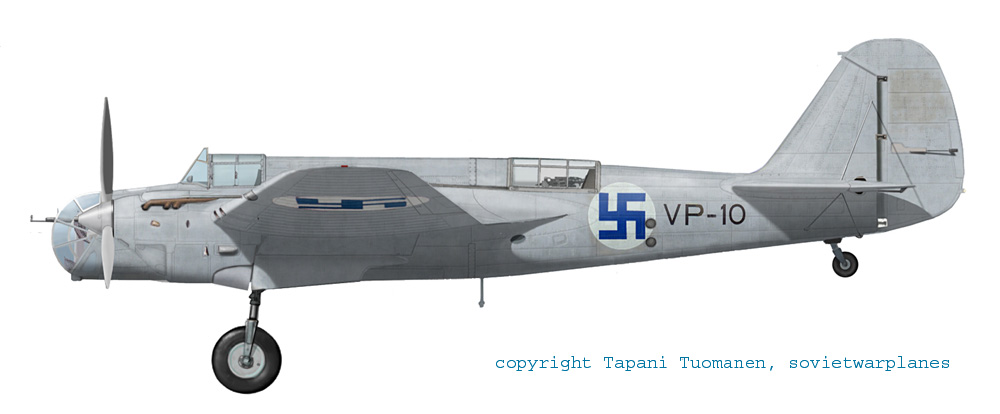
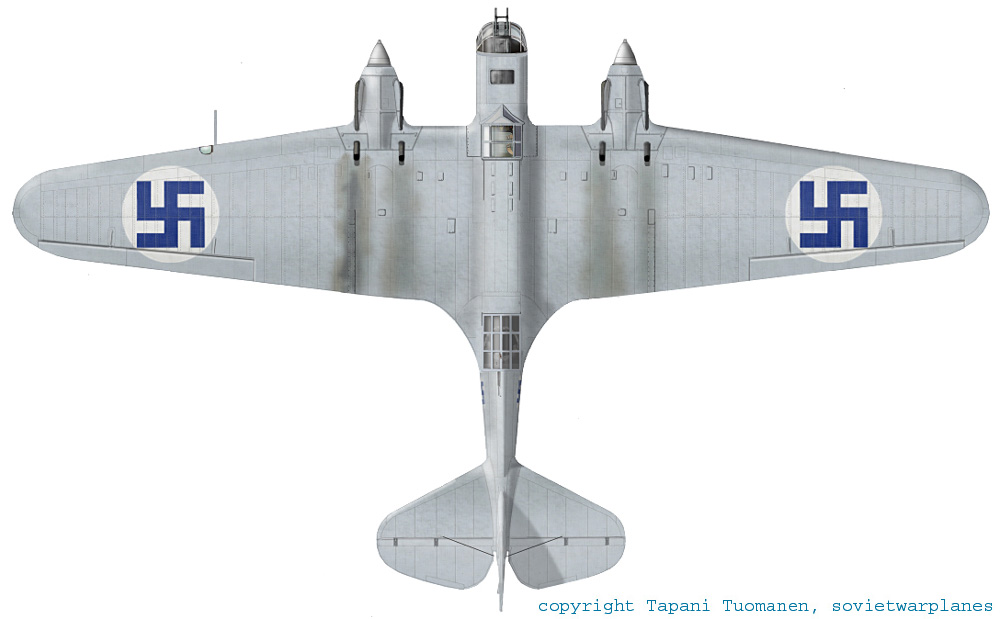
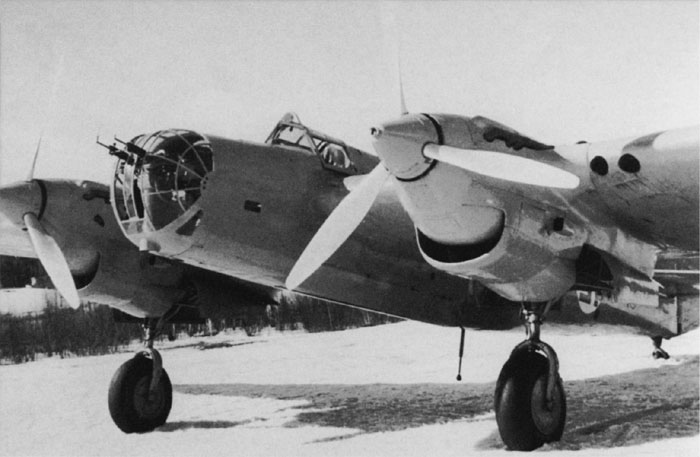
VP-10 was the first of seven SB-10-2M103 captured during the winter war to be put into Finnish service in August 1940, when it was delivered to 2/LeLv6 at Nummela.
On this photo, probably taken before that date, the plane seems to have been repaired, but the repainting with light grey is limited to the lower surfaces that were damaged in the forced landing.
Note that the slots of the machine guns on the nose are not yet closed with transparent panels.
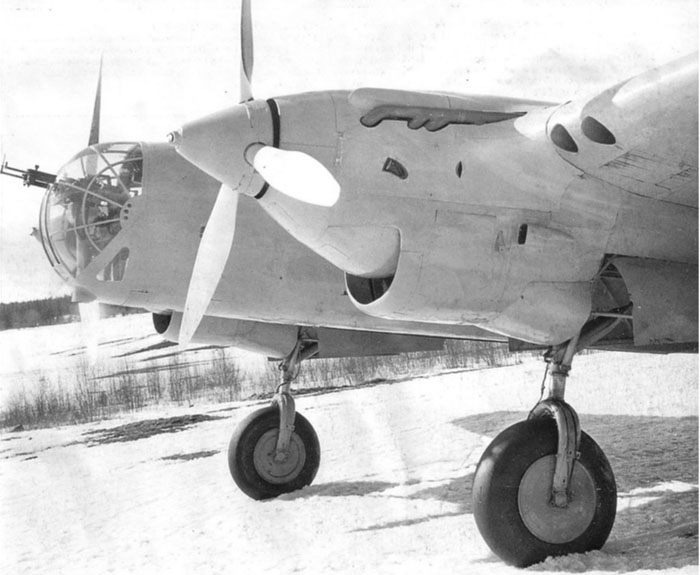
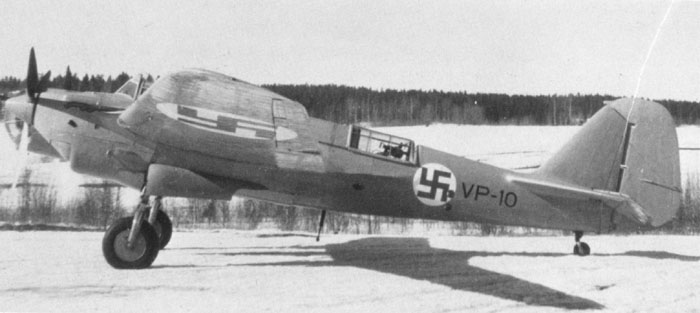
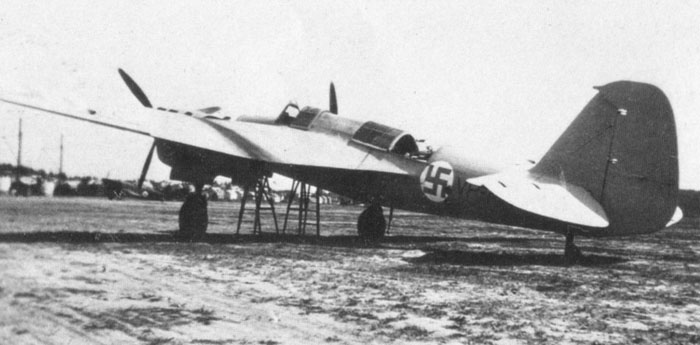
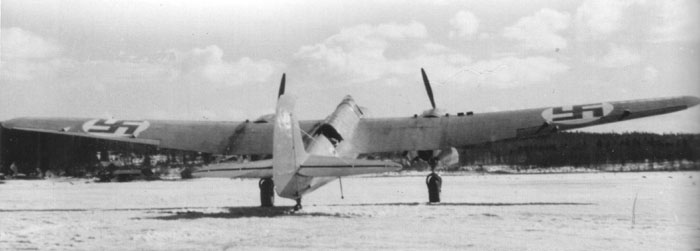
Further photos of the same plane.
The first style of national insignia on the wings were 185 cm wide, but they were replaced with smaller ones of 100 cm or less when the plane was camouflaged, probably in late 1940 or early 1941.
VP-10 was re-coded as VP-1 in June 1941.
The code VP-1 was changed into SB-1 in September 1941.
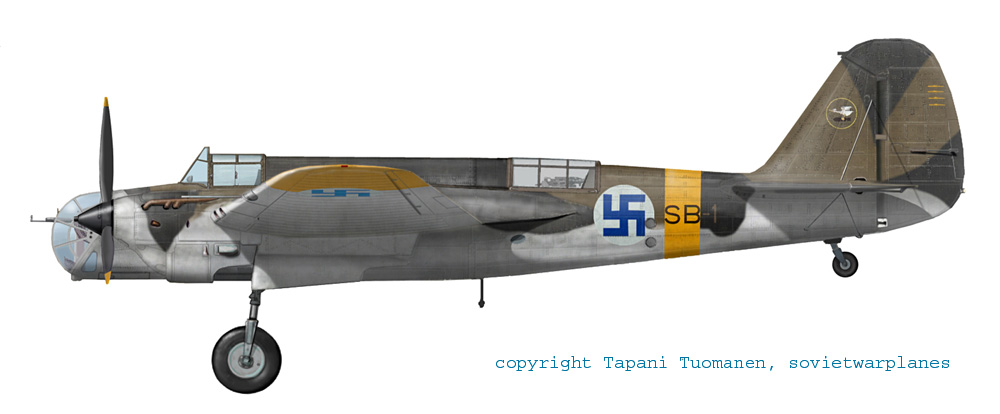
Drawing of Tapani Tuomanen
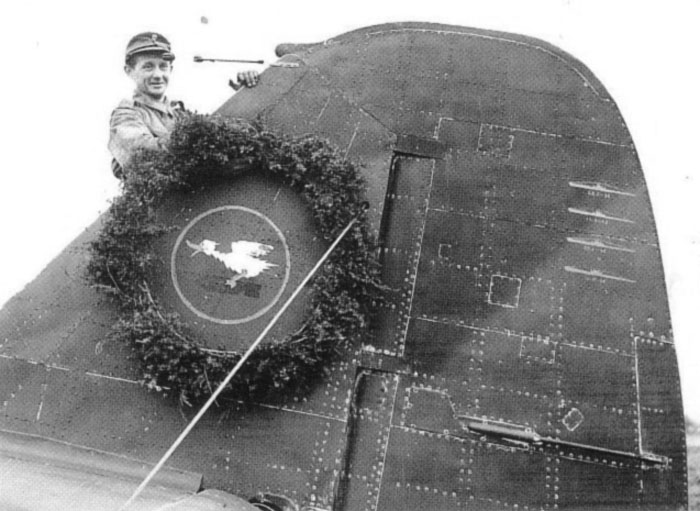
A detail of the emblem of 2/LeLv6, a white duck carrying a black bomb, inscribed into a thin yellow circle. This emblem wasn't on all Finnish SB.
SB-1 flown by Lt.Virtanen sank the coastal Soviet submarine M-95 on
28
May 1942.
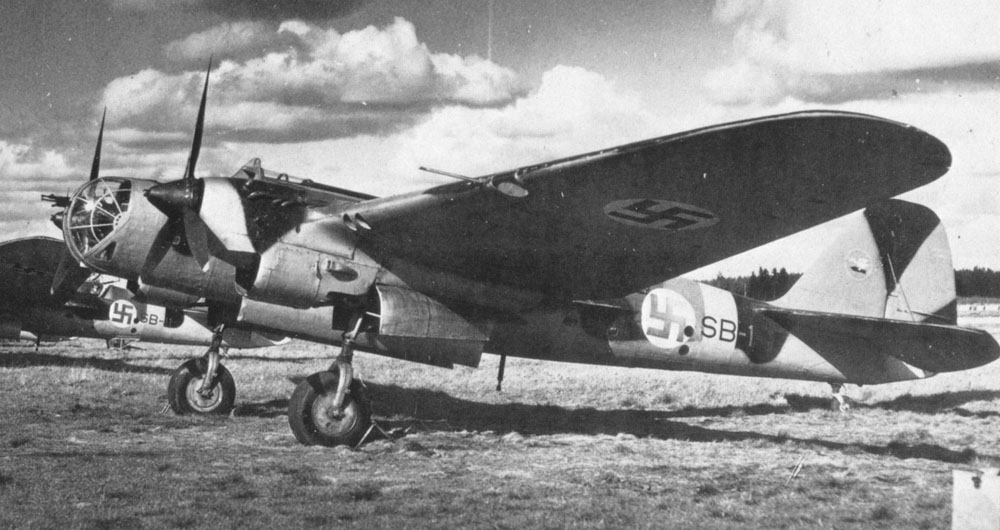
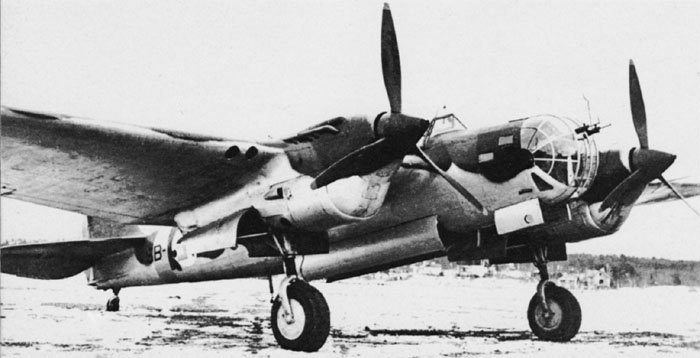
Above:
SB-1 in the early camouflage.
On the background, we see SB-11, that arrived in Finland in November 1941; so, it is likely that this photo was taken in spring 1942.
Aside:
SB-1 with the early camouflage.
Some big repairs after damage were made between 15.2.43 15.7.43.
It operated with PLeLv 45 in Lapland War in late 1944, with yellow bands deleted.
The plane survived the war and was placed in storage on 2 February 1945.
(image Klaus Niska, from Tupolev SB in action, Squadron Signal)
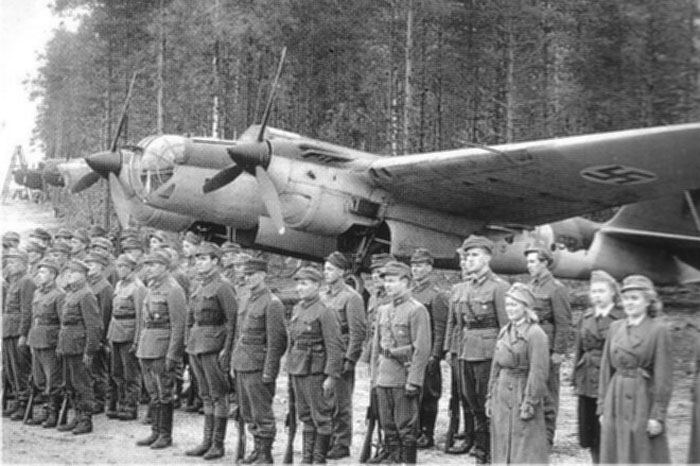
Aside:
SB-1 in Nummela airport in October 1944, during the Lapland War after the armistice with the Soviet Union.
Note the deletion of all the yellow bands, repainted with base colors.
The background of the swastikas on the fuselage (and probably over the wings) was repainted light grey, while the swastikas under the wings seems to have preserved the original white disk.
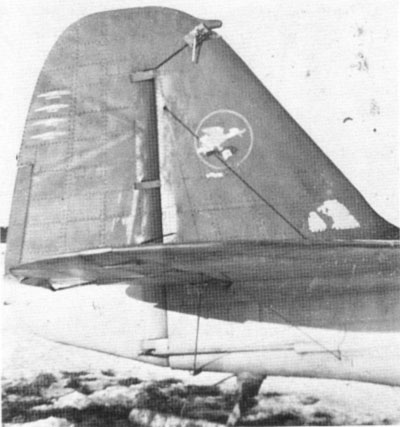
ASide:
detail of the tail of SB-1.
Note that the plane is equipped with skis.
The plane could be already on storage (as the photo of SB-16) after the war.
Note the ski equipment, common to the postwar photo of SB-16 too; this could mean that the last missions during the Lapland War were made with this equipment.
It is likely that the plane had already received postwar cockades when the photo was taken.
VP-2/SB-2
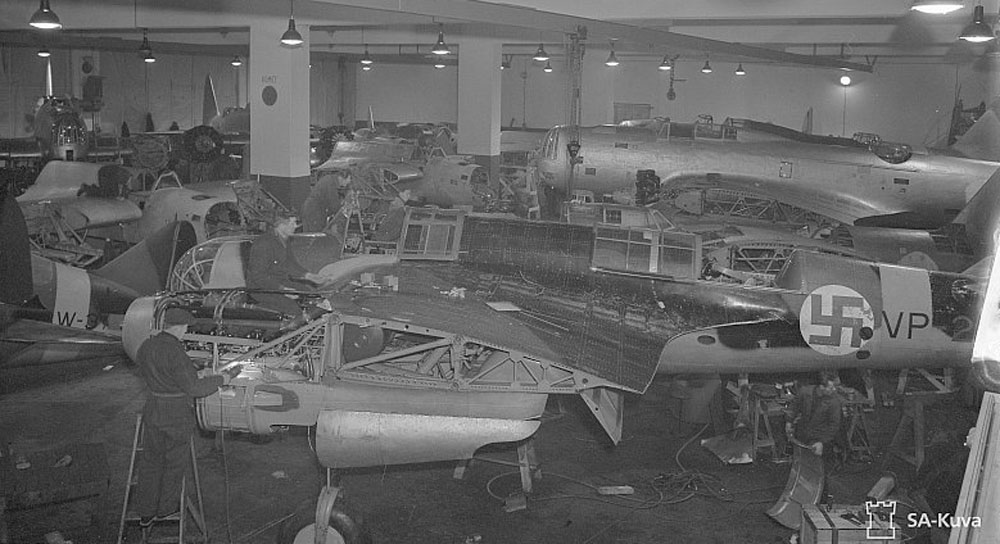
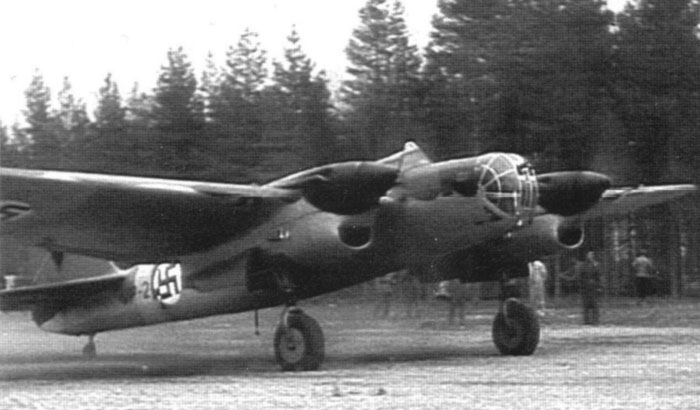
Top:
VP-2 on maintenance at VL in summer 1941. Note that there are still some SB in grey-silver, not yet delivered to the Ilmavoimat.
aside: the same plane in action in summer 1941.
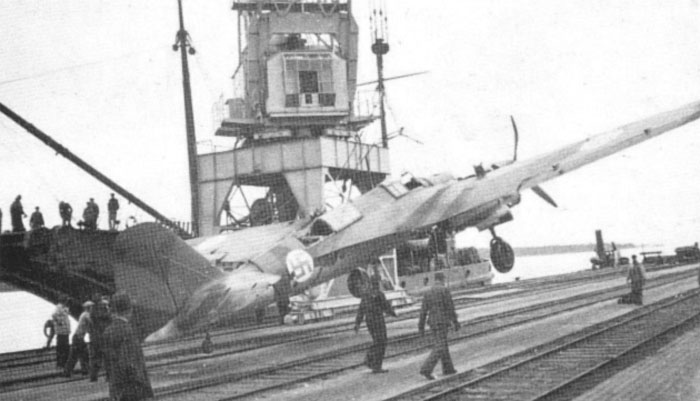
Aside:
this image of VP-2 lifted by a crane is useful for a reconstruction of the early camouflage pattern over the wings.
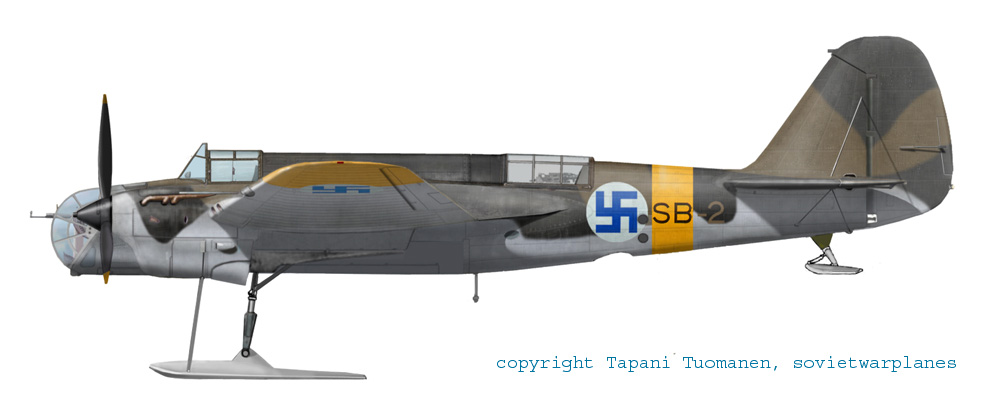
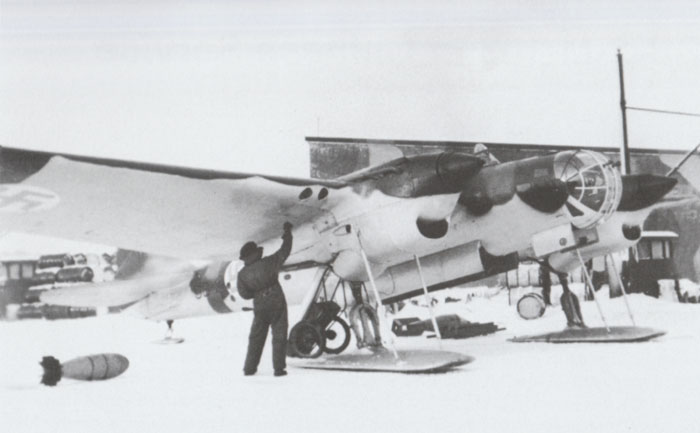
Above:
profile of SB-2 operating with skis in winter 1941/42. The skis were of retractable type, with two rigid rods containing springs that connected the front of the skis to the sides of the nacelles. Those rods rotated backward, maintaining the skis parallel to the plane when in up position.
Alternatively to the retractable arrangement, Soviet SB could feature also unretractable skis, connected by one spring under the cowling and one wire on the rear part; in this case, the bays can also be closed by an apposite cover.
Aside:
SB-2 operating with the early camouflage and ski gear in winter 1941/42.
The plane was lost in a crash landing near Malmi on 6 April 1942.
(image Keski-Suomen Ilmailumuseo, from Tupolev SB in action, Squadron Signal)
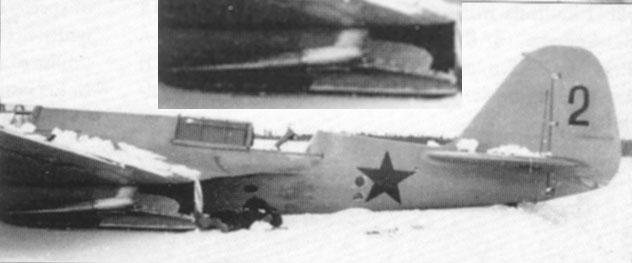
Aside:
Detail of a downed SB with ski gear, perhaps the same that became SB-2, during the Winter War.
We can see clearly the ski in retracted position, ending much behind the nacelle.
The landing gear bays had their doors removed and replaced with fixed panels to restrict them, allowing the retraction of the struts and adhering to the skis in retracted position.
VP-3
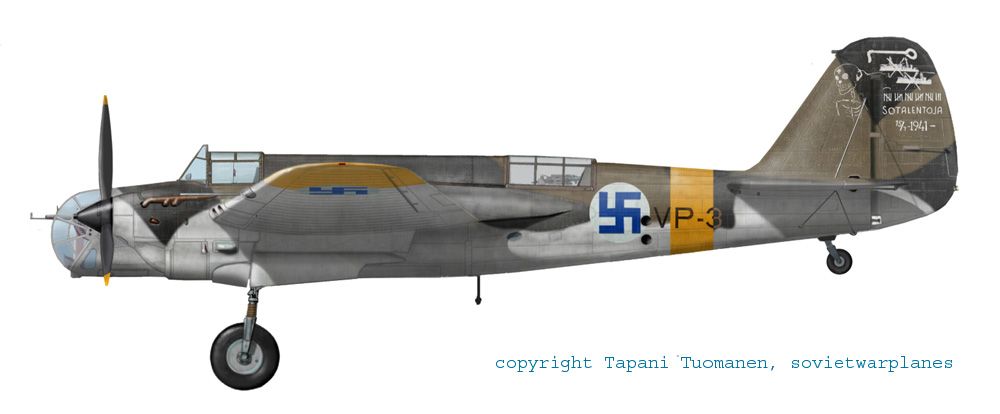
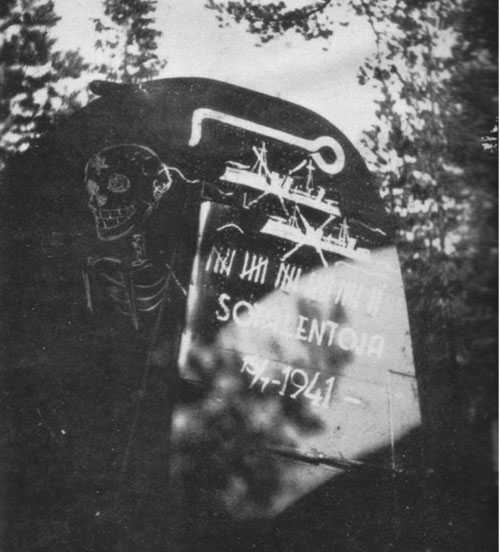
VP-3 was captured in Winter War and delivered to 2/LeLv6 (2nd Squadron) on July 15 1941.
VP-3 was the first SB lost by the unit: it crashed after a stall during takeoff at Nummela on 2 August 1941, so it was never recoded SB-3.
The only photos found of this plane are of a tail with unique marling's, plus some of the crashed wreck. The plane had the early type of dorsal postation without MV-3 turret. The profile shows, hypothetically, the movable type air intake for the coolers.
What makes this interesting is the tail fin, with unique markings. These missions were marked for the whole squadron, they were not individual victories of this plane.
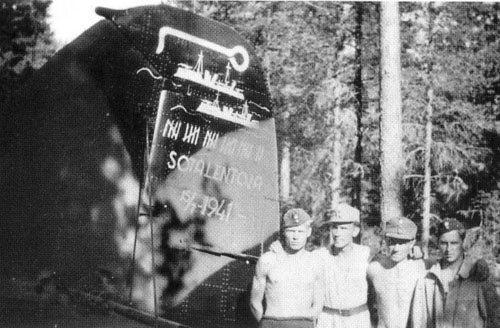
VP-4/SB-4
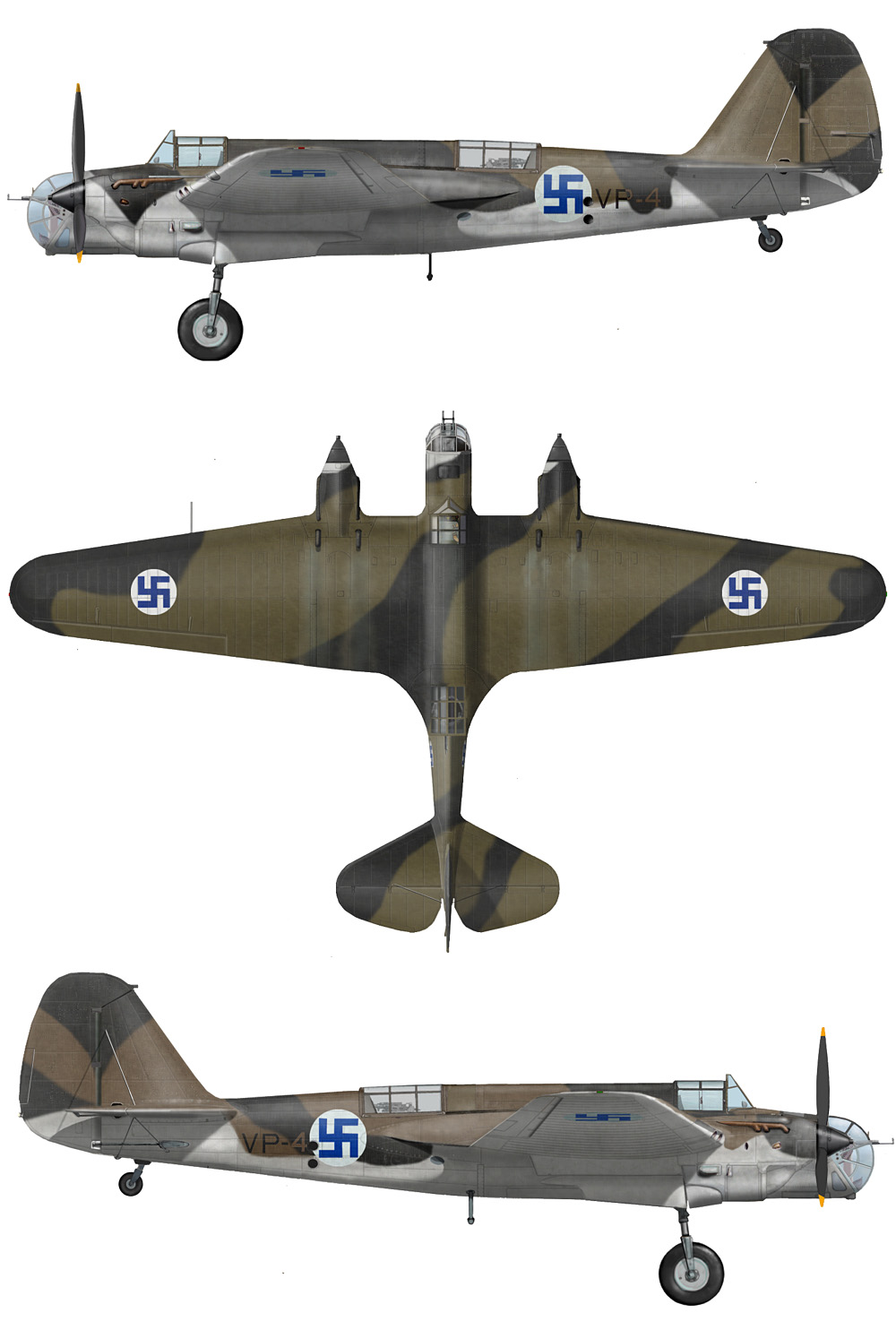
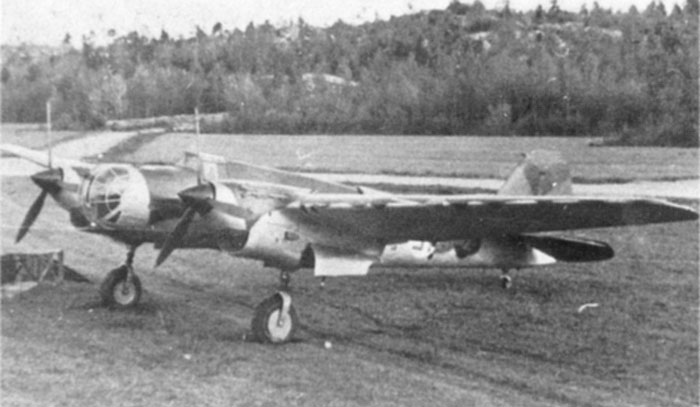
Above:
three views of VP-4 in spring 1941, before the start of the continuation war. The drawing shows the early standard camouflage of early 1941, more or less representative of all the early Finnish VP/SB up to, at least, VP/SB11.
Aside: the same plane before the war
The intakes of the coolers are of the movable flaps type, and the landing light is on the left wing.
The dorsal gun position is closed with a sliding windshield.
The plane is still without the wartime yellow bands, and still lacking of the radio mast and wire on the windshield.
The Finnish sliding hood and foldable windshield on the navigator's position were not yet installed.
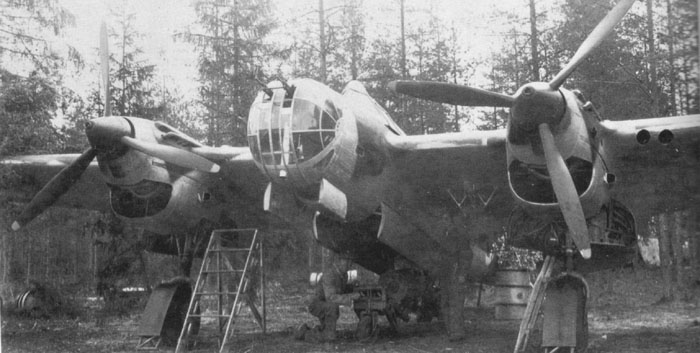
Left:
a photo of VP-4, still with the early camouflage. The movable flaps of the cooling inlets seem removed for maintenance. The plane hasn't yet received the radio mast on the windshield.
VP-5/SB-5
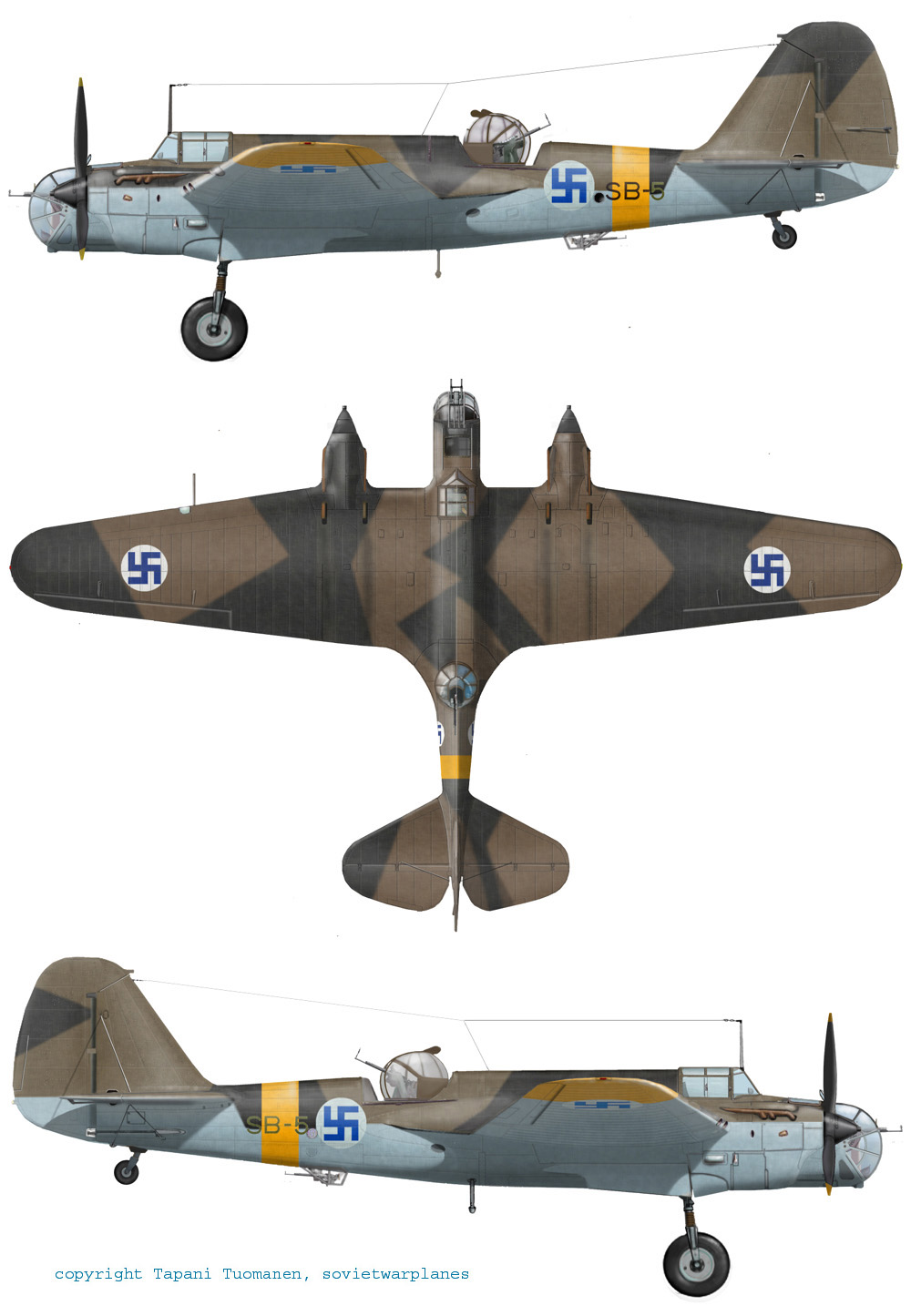
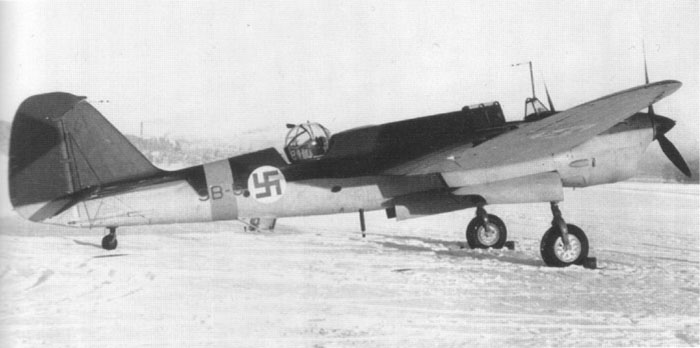
Above: 3 views of SB-5 with the later 'splinter' camouflage adopted in summer 1942.
The plane features fixed inlets of the coolers, and was updated with an MV-3 ball turret; this was not installed when the plane was built, because the gap between the turret and the fuselage skin is very wide.
Besides, it had the MV-2 ventral turret instead of the simple hatch for firing.
Aside: SB-5 at the factory at Tampere in January 1943.
Below: another photo of the same plane, allowing to see how the later camouflage goes over the wings.
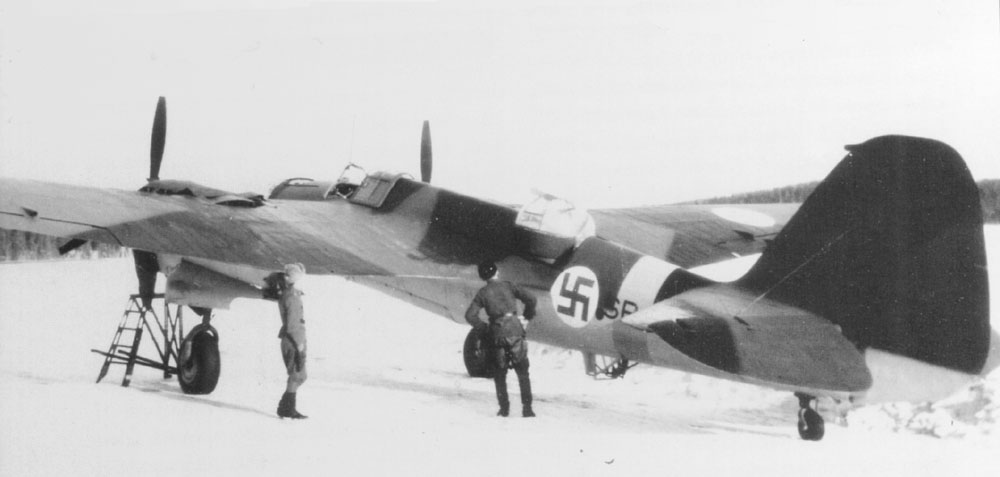
VP-6/SB-6
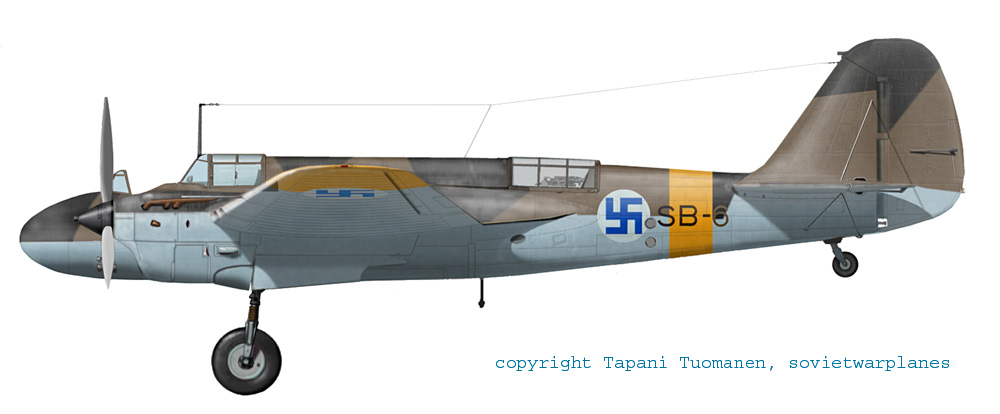
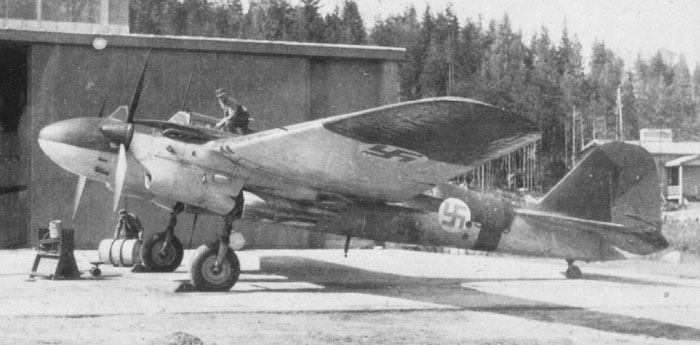
Above: profile of SB-6 with USB nose.
The plane was captured in the Winter War, as basic SB-2M103 with fixed coolers intakes.
It was converted to USB trainer later, probably using a nose section
of German war booty.
Aside and below:
photos of SB-6 as a trainer. Note that the landing light was on the right wing.
About the airfield -actually the scrap field- i can count several
SBs and at least one with early camo, but these aircraft are
unidentified, and only note is that splinter camos looks variable
plane by plane. I know that this "Härmälä graveyard"
was largely
photographed by private people in Tampere. I have seen some originals
on second hand markets, but have no idea where to catch these.
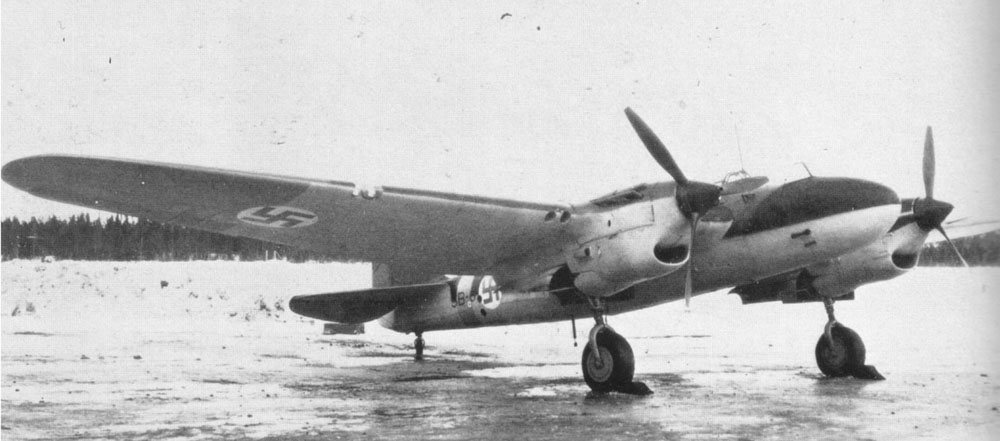
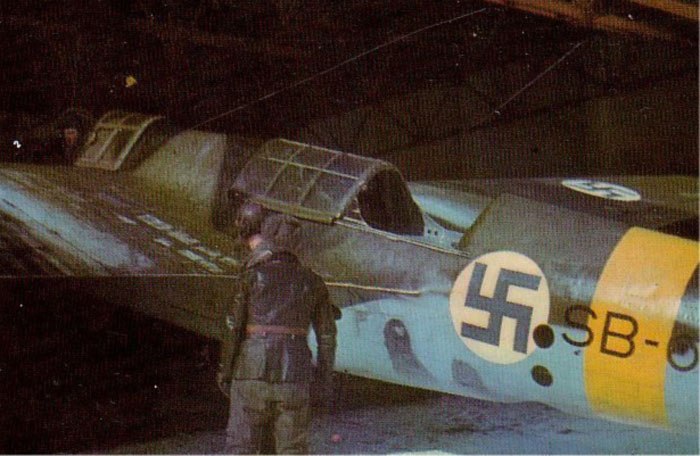
Left:
rare color photo of SB-6. Note the absence of the machine gun and of the relative ring.
Below:
great color image (or colonized?) of SB-6 taxiing on the ground.
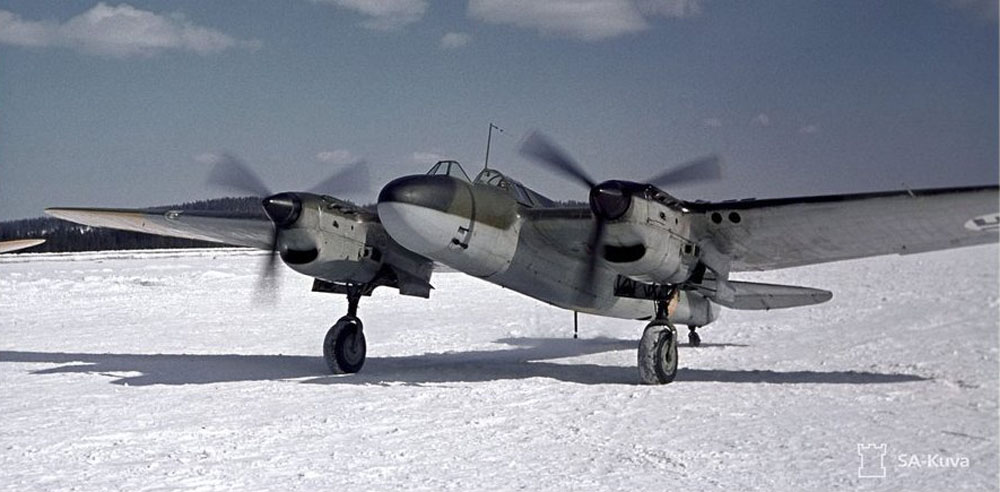
VP-7/SB-7
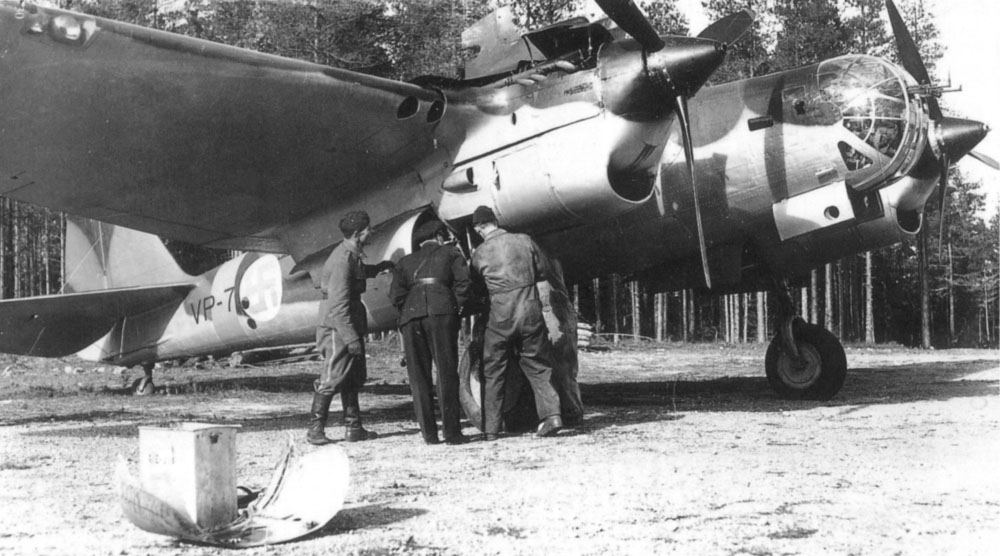
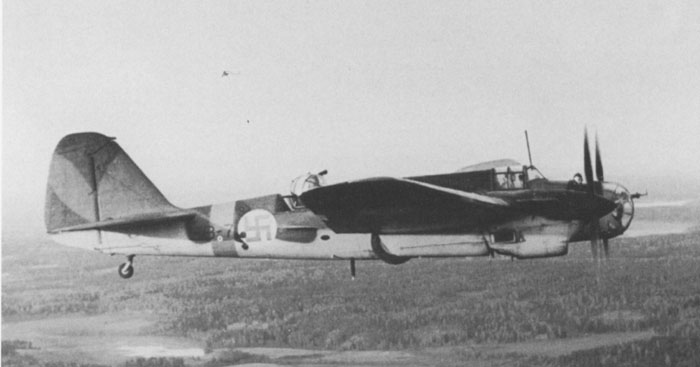
Above: VP-7 with the later livery. The plane has fixes intakes for the cooler of its M-103 engines.
Aside: the same plane, now SB-7, inflight with the later livery. The MV-3 ball turret is clearly visible.the large gaps between turret and fuselage reveal that the turret was refitted after building the plane.
VP-8/SB-8
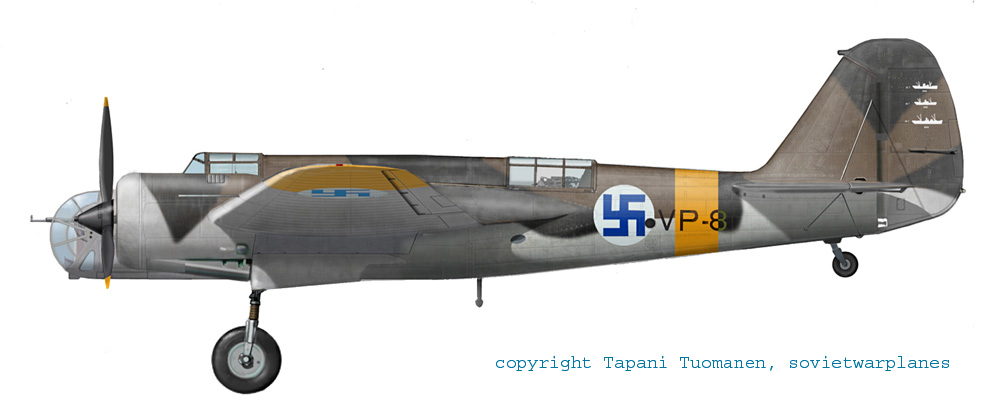
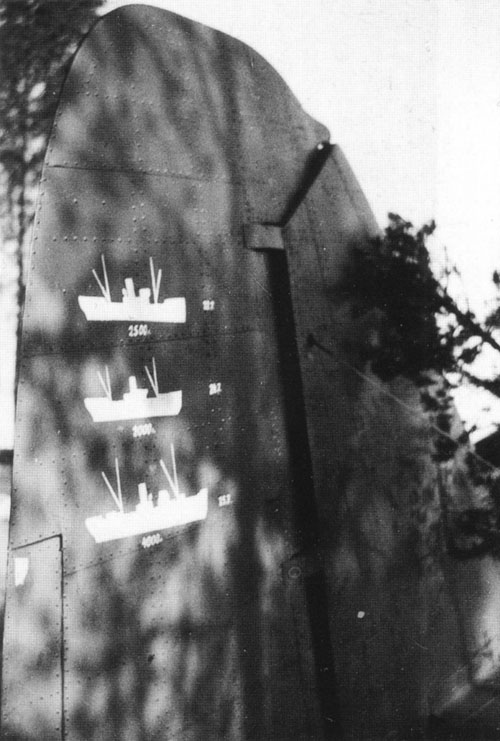
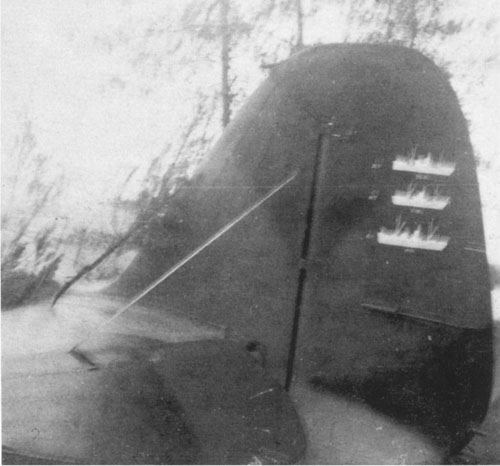
VP-8, here shown with the earlier camouflage, was the only Finnish one that had the earlier style of coolers with flat front; anyway, the engines were M-103 as on all the Finnish SBs.
It was captured during the Winter War and delivered to 2/LeLv6 on June 21, 1941.
Left: two images of the rudder with the victory marks.
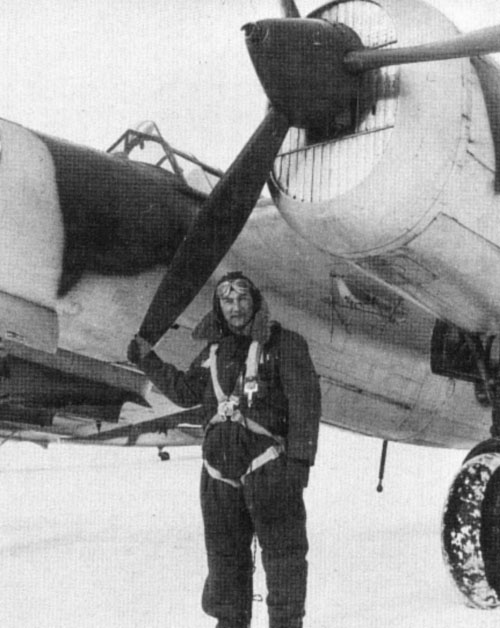
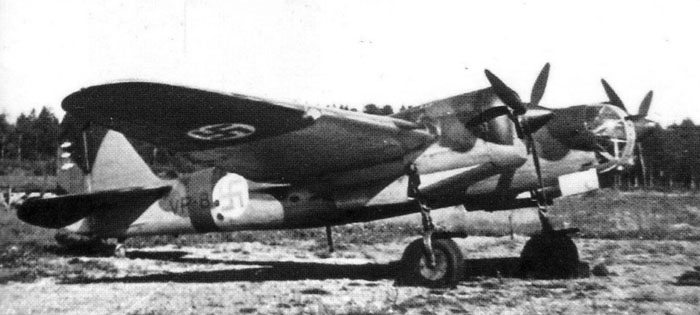
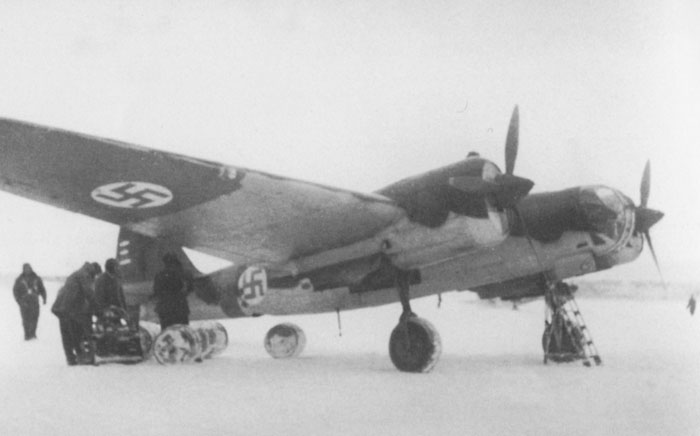
Another photo of VP-8 (or SB-8) on a snowy background.
It was later converted into USB on March 1 1943.
The plane crashed soon after the take off from Luonetjarvi on 25 October 1944.
SB-9
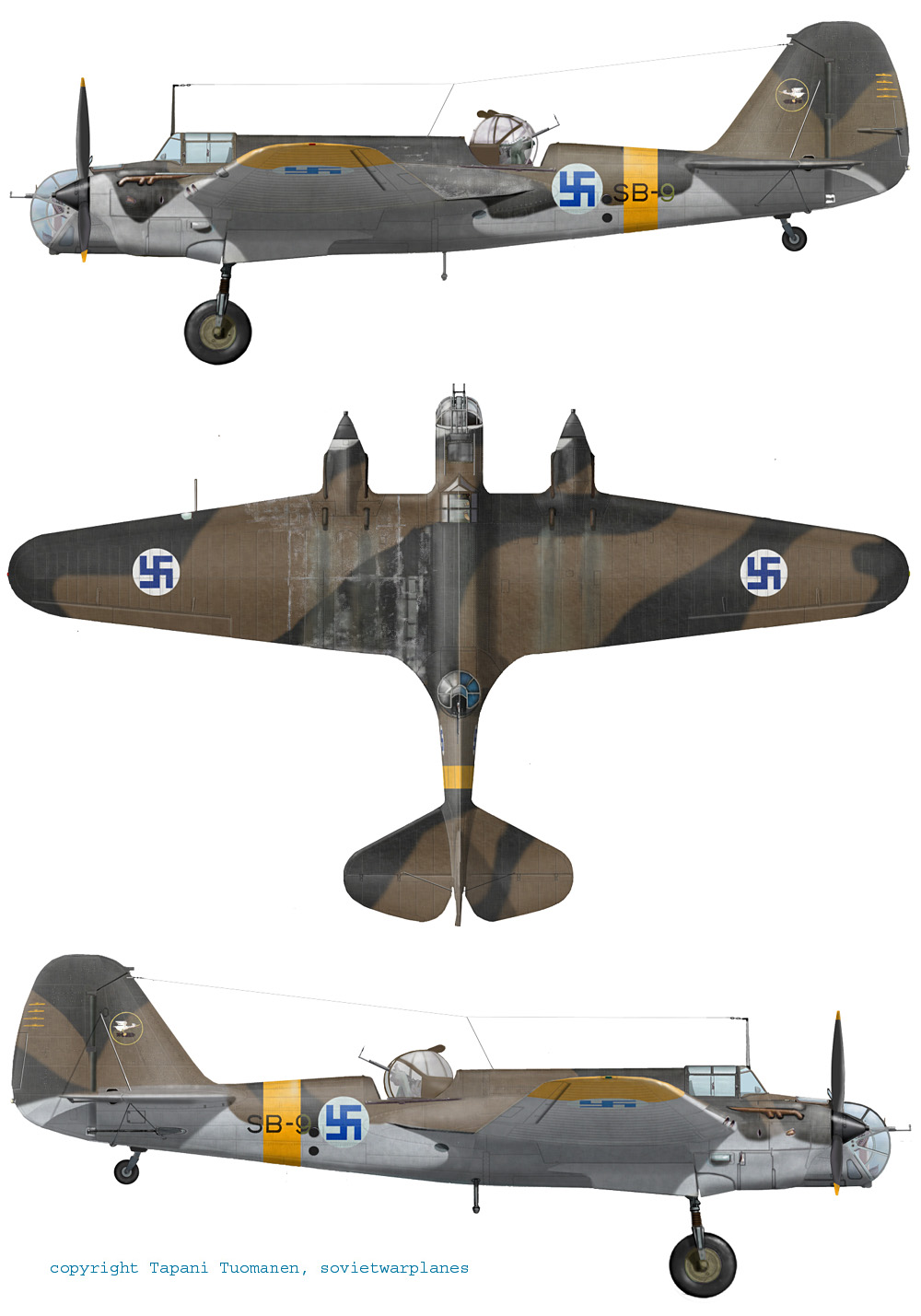
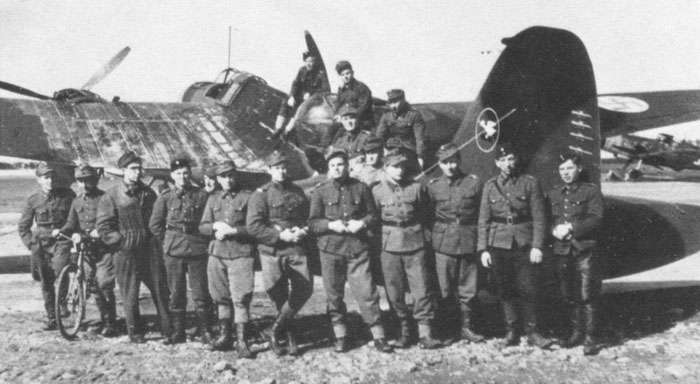
The plane was part of a batch delivered to the Ilmavoimat by Germany in November 1941, and was immediately coded SB-9 (never VP-9).
The photos are probably of the spring 1942, and show the earlier style of camouflage, extremely worn on the wing roots.
The photos show that the M-103 engines had fixed inlet cooling intakes, MV-3 dorsal turret, and landing light on the left wing.
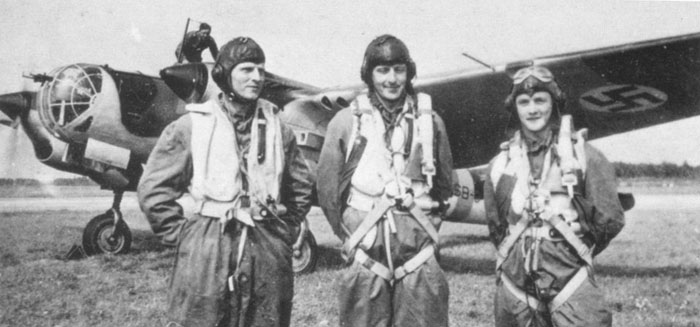
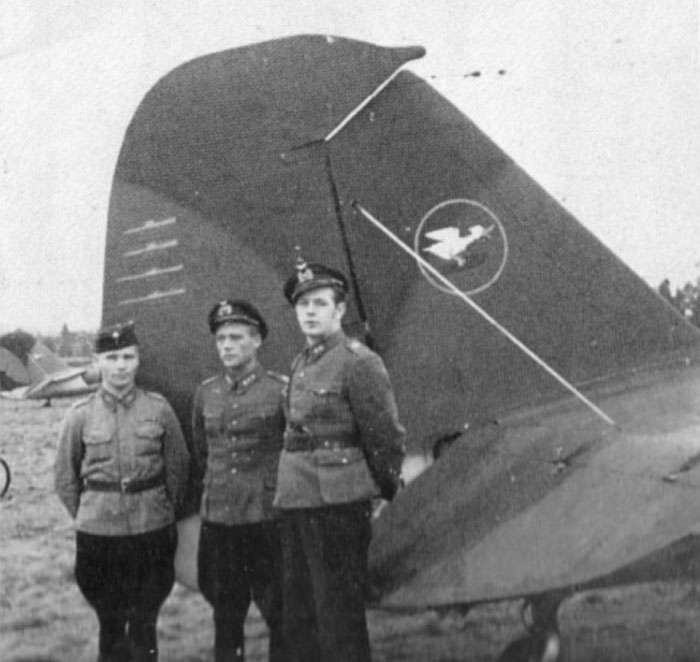
The photo shows the tail with the emblem and the shapes of four boats or submarines, presumably in yellow.
Note that the camouflage of the plane on the background is much sharper; probably the repainting of the planes with the new camouflage in 1942 was gradual.

SB-10
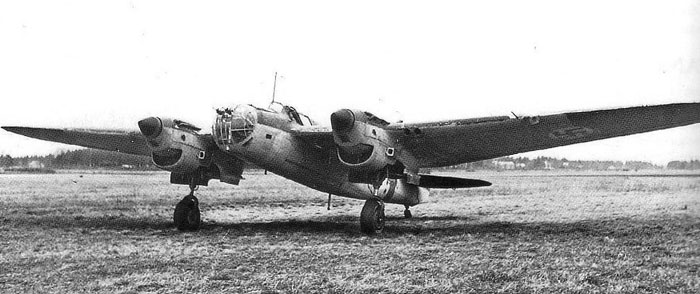
SB-10 (not the same plane of VP-10, that became VP-1 and later SB-1) arrived in Finland in November 1941.
Aside:
SB-10 photographed on 21 October 1943.
As one can see, the plane has the splinter camouflage, easily recognizable because of the straight division between the painting of upper and undersurfaces.
The air intakes are of the early type, with movable flaps; the landing light is on the left wing.
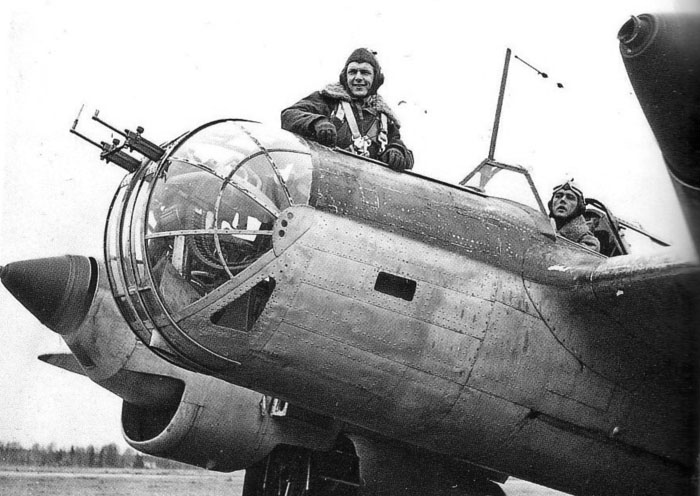
Another photo of SB-10 taken in the same day, when 2/LeLv6 made its 1000th sortie.
We see the navigator 1lt N-V. Halla and the pilot capt B.Ek.
The observer's sliding hatch guides are clearly visible, while the foldable windshield, not contrasting to the sky, can be perceived by the cut of the man's manifold.
SB-11
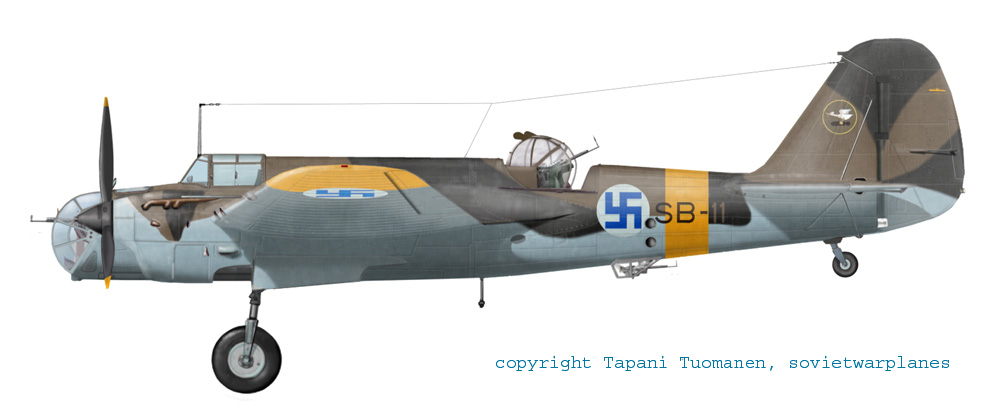
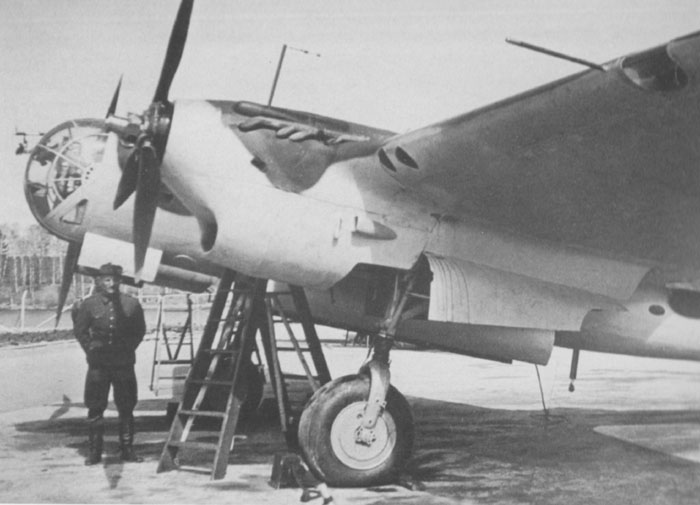
SB-11 (never MV-11) was delivered to the Finnish Air Force by Germans in November 1941, and assigned to 2/LeLv6.
Here we see the plane during maintenance, with the spinner removed. It has the early camouflage.
The plane was provided with the ventral MV-2 turret.
SB-11 crash-landed at Malmi on 24 September 1942, causing the explosion of the depth charges that completely destroyed the plane.
(Image Klaus Niska via Tupolev SB in action, squadron/signal publications)
SB-12
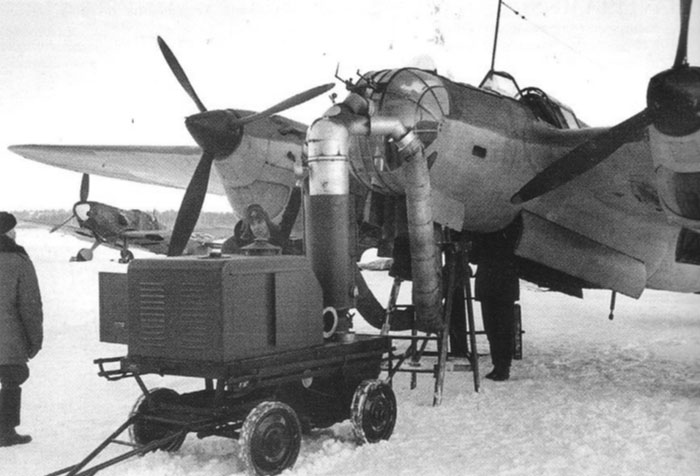
Aside:
SB-12 of 2/LeLv6 is being warmed for a winter mission from Malmi airfield on 7 January 1944.
Note the warming device on the ground.
The photo shows the shutters of the cooling tunnel intakes of the M-103 engines in fully closed position.
SB-13

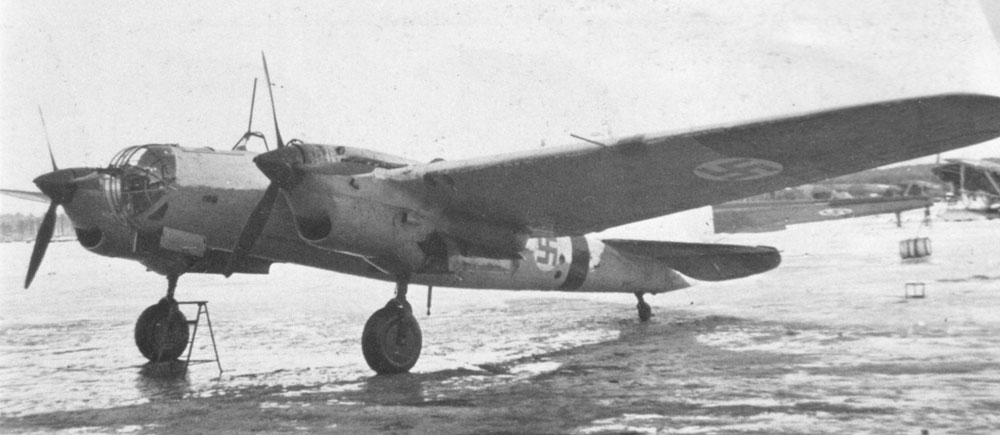
SB-13 (never VP-13) was delivered to the Finnish Air Force in November 1941.
We see that it shows an interesting white temporary camouflage.
Looking at the cowlings, it seems that the plane had the later style of camouflage under the white paint; so, the photo could be dated to winter 1942/43 or even later.
The photos show that the plane had fixed type cooler intakes, MV-3 turret and landing light on the left wing.
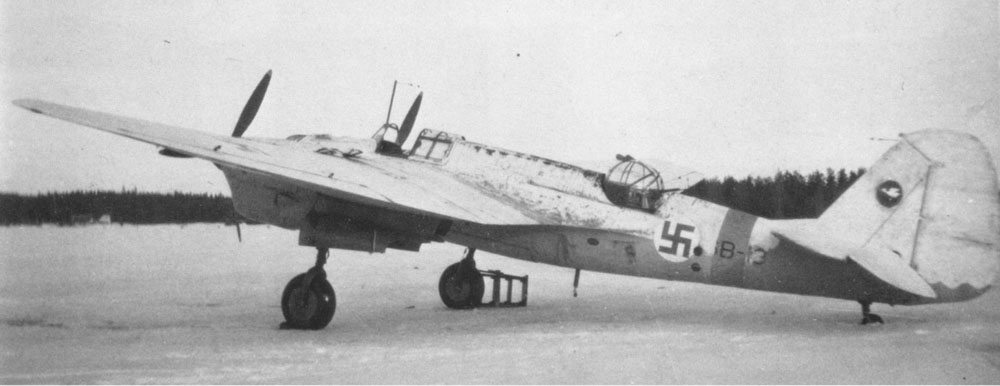
SB-14

SB-14 reached Finland from Germany in November 1941.
Aside: image of SB-14 with the late camouflage.
The fixed cooler intake, the MV-3 turret and the emblem of LeLv6 are noteworthy.
SB-16
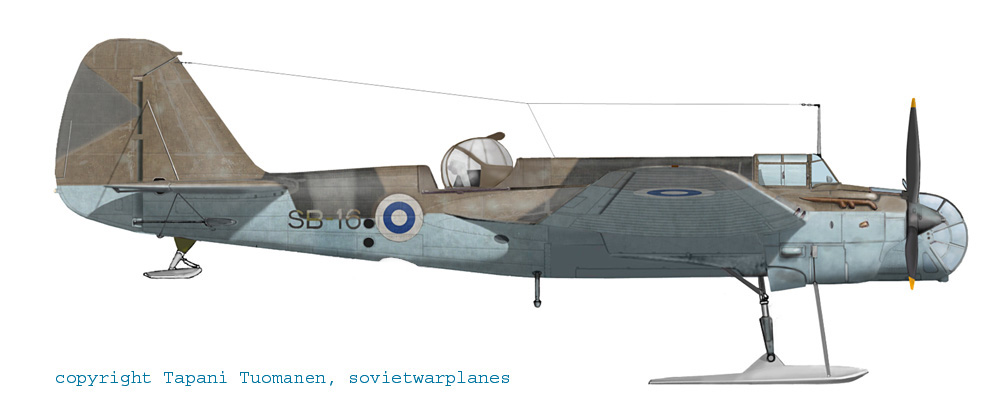
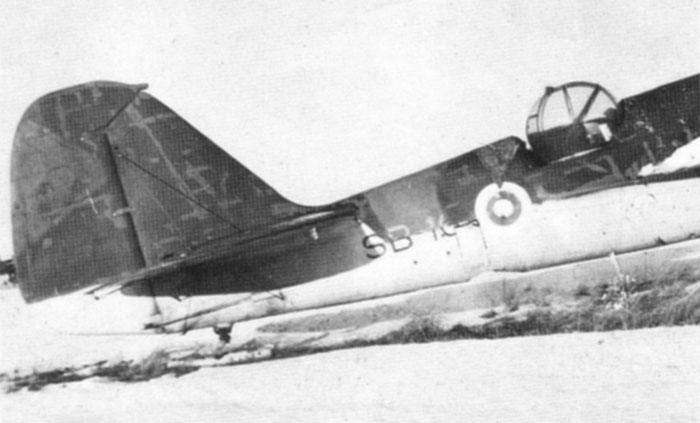
SB-16 was of the batch of 5 SB delivered to Finland in April 1942.
Above and aside:
SB-16 on storage after the war's end, probably in winter 1945/46.
The postwar roundels were painted on planes on storage too, but they never flew with these marks.
The machine guns were removed, and the painting appears markedly worn, with bad lighter retouches with an unknown color, supposedly grey.
The repainting on the rudder probably covered some victory marks, that had become embarrassing after the armistice with the Soviet Union.
The photo shows the plane wearing skis. It's likely that the last flights of the plane during the Lapland War were made with this equipment.
On the profile, the coolers intakes were supposed of the fixed type.
SB-17

SB-17 was of the batch of 5 delivered to Finland in April 1942.
SB-18
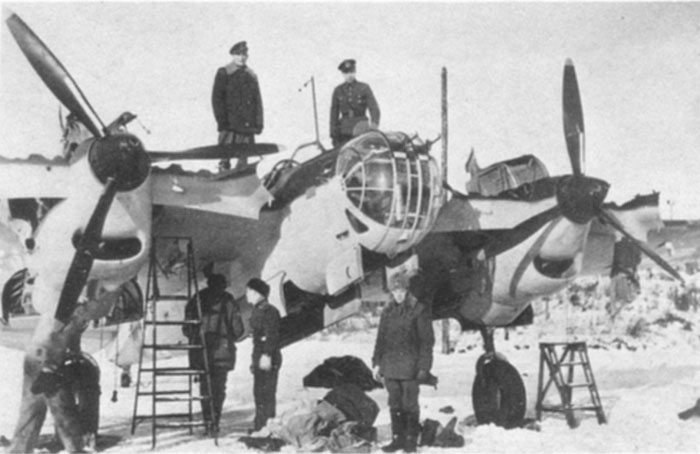
SB-18 was of the batch of 5 delivered to Finland in April 1942.
Aside: SB-18 in 1943; the plane was assigned to 1/LeLv6.
The plane had fixed cooler intakes and later style camouflage.
SB-19
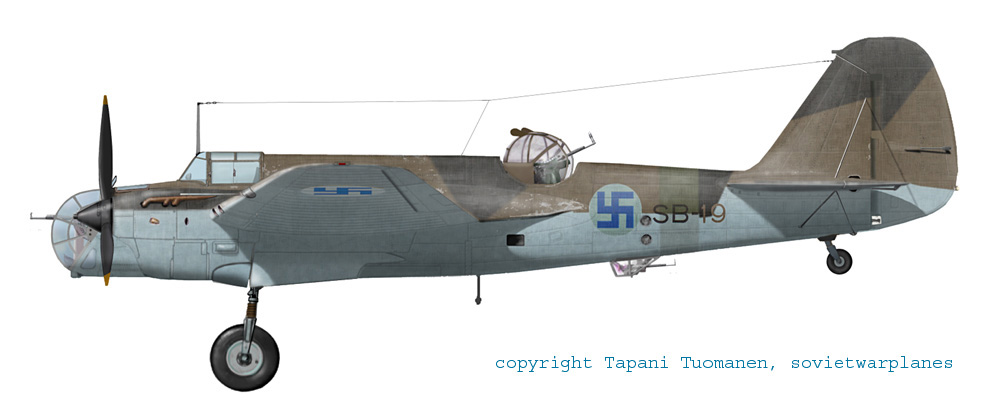
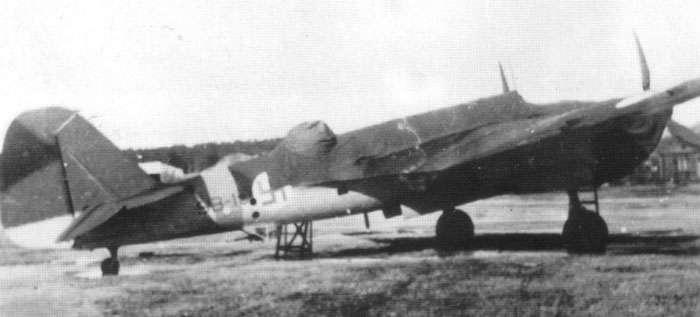
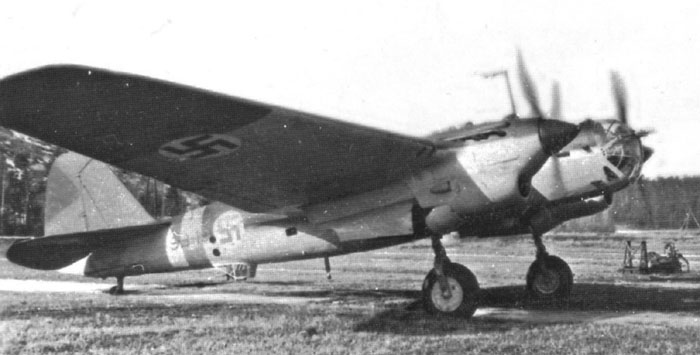
Above:
profile of SB-19, as it likely appeared during the Lapland War, with the white background of the swastikas repainted grey on the upper and side surfaces, while it probably remained white on the wing undersurfaces as on SB-1; all the yellow bands were deleted in September 1944, after the armistice with the Soviet Union.
Aside: photo of the same plane in 1942 or 1943.
The plane was received from Germany in April 1942. It is not clear if it was at first painted with the early style camouflage, or entered service already painted in the later style.
We see that the plane had fixed coolers of the intake, MV-2 and MV-3 turrets, and landing light on the left wing.
SB-20
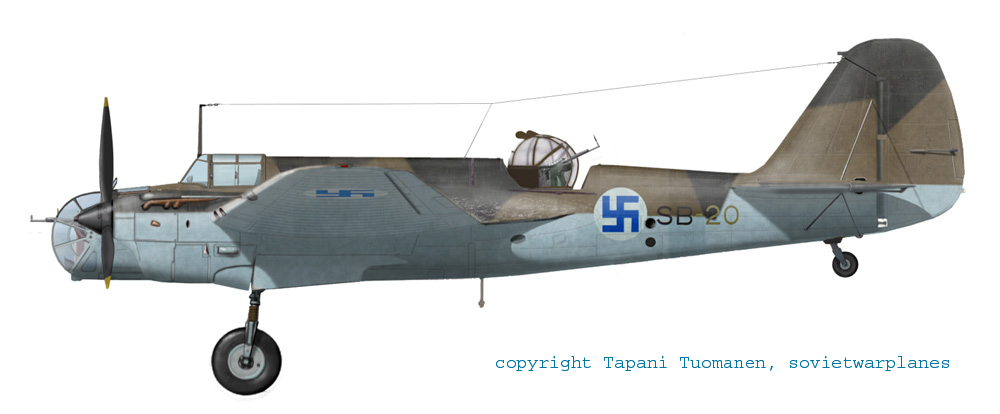
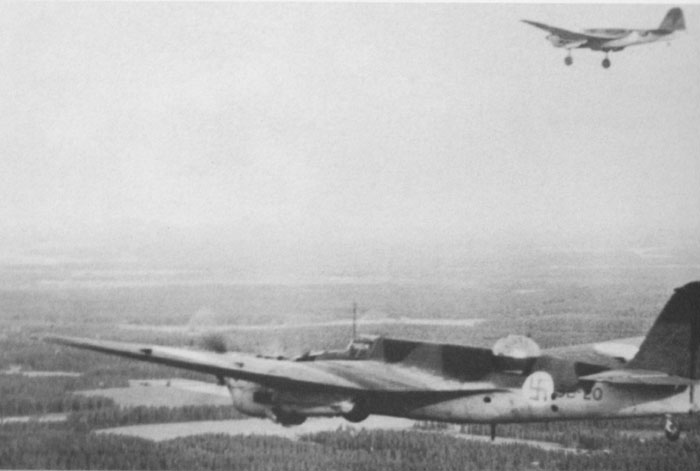
Above:
profile of SB-20 operating against Germans in the Lapland war, after the armistice with the Soviet Union of 4 September 1944. The yellow bands, marking their lost alliance with Germans, were deleted with camouflage colors. The background disks of the national insignias were still white.
SB-20 (never VP-20) was the first of the last batch of five (SB-20 to 24) delivered by Germans in August 1942. So, it was put into service already with the later style of camouflage.
Left:
the photo shows SB-20 operating against Germans on 21 October 1944, after the armistice with the Soviet Union of 4 September 1944.
The plane on the background seems to have problems in retracting its landing gear.
SB-22
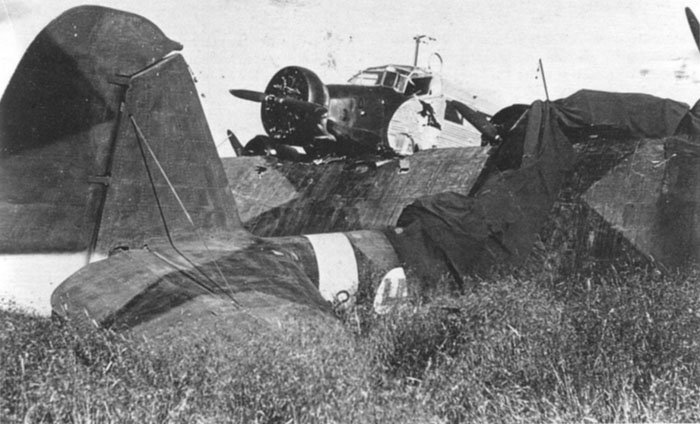
SB-22 was delivered to Finland in August 1942.
It was lost on a ground collision, hit by a AERO Ju-52 that lost its brakes.
SB-23
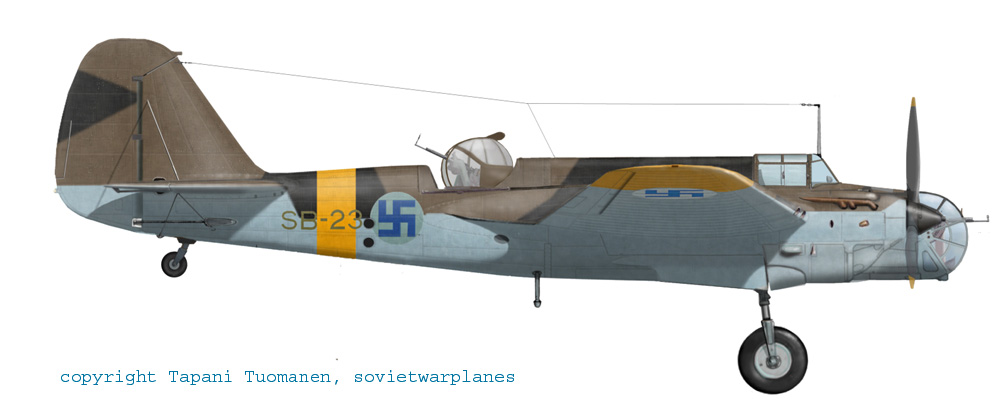
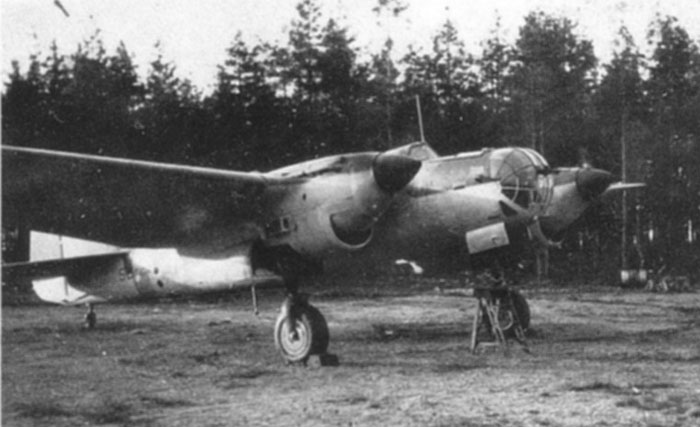
SB-23 was received by Finland on August 1942.
Above: profile of SB-23 as it likely appeared in mid 1944, when the background of the swastikas on upper and side surfaces were repainted grey; it is likely that the backgrounds on the lower wing surfaces were left white as on SB-1.
Aside: the only photo found of SB-23.
Note the cooling intakes with movable shutters.
Below:
profile of SB-23 as likely appeared during the Lapland War in late 1944, after the deletion of the yellow bands.
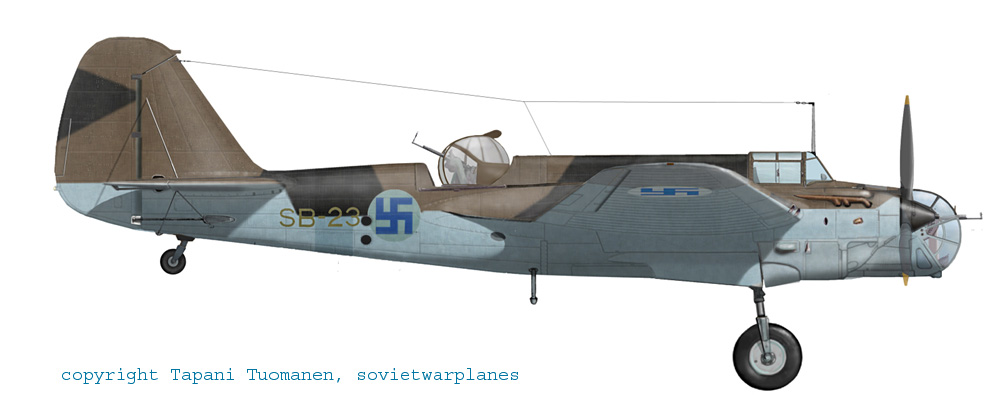
SB-24
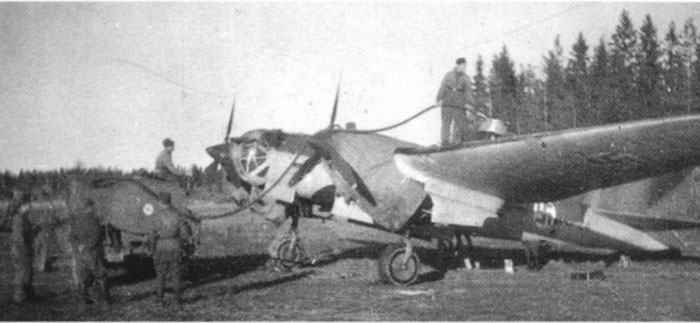
SB-24 was the last SB received by Finland, in August 1942.
Aside: the photo shows the plane while being refueled.